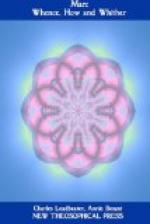We may say broadly that concerning the origin of species two theories, and only two, seem possible. The first theory is that every species is the result of an act of immediate creation. And every true species, however slightly it may differ from its nearest relative, represents such a creative act, and once created is practically unchangeable. This is the theory of immutability of species. According to the second theory all higher, probably all present existing, species are only mediately the result of a creative act. The first living germ, whenever and however created, was infused with power to give birth to higher species. Of these and their descendants some would continue to advance, others would degenerate. Each theory demands equally for its ultimate explanation a creative act; the second as much as, if not more than, the first. According to the first theory the creative power has been distributed over a series of acts, according to the second theory it has been concentrated in one primal creation. The second is the theory of the mutability of species, or, in general, of evolution, but not necessarily of Darwinism alone.
The first theory is considered by many the more attractive and hopeful. Now a theory need not be attractive, nor at first sight appear hopeful, provided only it is true. But let me call your attention to certain conclusions which, as it appears to me, are necessarily involved in it. Its central thought is the practical immutability of species. Each one of these lives its little span of time, for species are usually comparatively short-lived, grows possibly a very little better or worse, and dies. Its progress has added nothing to the total of life; its degeneration harmed no one, hardly even itself; it was doomed from the start. Progress there has been, in a sense. The Creator has placed ever higher forms on the globe. But all the progress lies in the gaps and distances between successive forms, not in any advance made, or victory won, by the species or individual. The most “aspiring ape,” if ever there was such a being, remains but an ape. He must comfort himself with the thought that, while he and his descendants can never gain an inch, the gap between himself and the next higher form shall be far greater than that between himself and the lowest monkey.
And if this has been the history of thousands of other species, why should it not be true of man also? Who can wonder that many who accept this theory doubt whether the world is growing any better, or whether even man will ever be higher and better than he now is? Would it not be contrary to the whole course of past history, if you can properly call such a record a history, if he could advance at all? Now I have no wish to misrepresent this or any honestly accepted theory, but it appears to me essentially hopeless, a record not of the progress of life on the globe, but of a succession of stagnations, of deaths. I can never understand why some very good and intelligent




